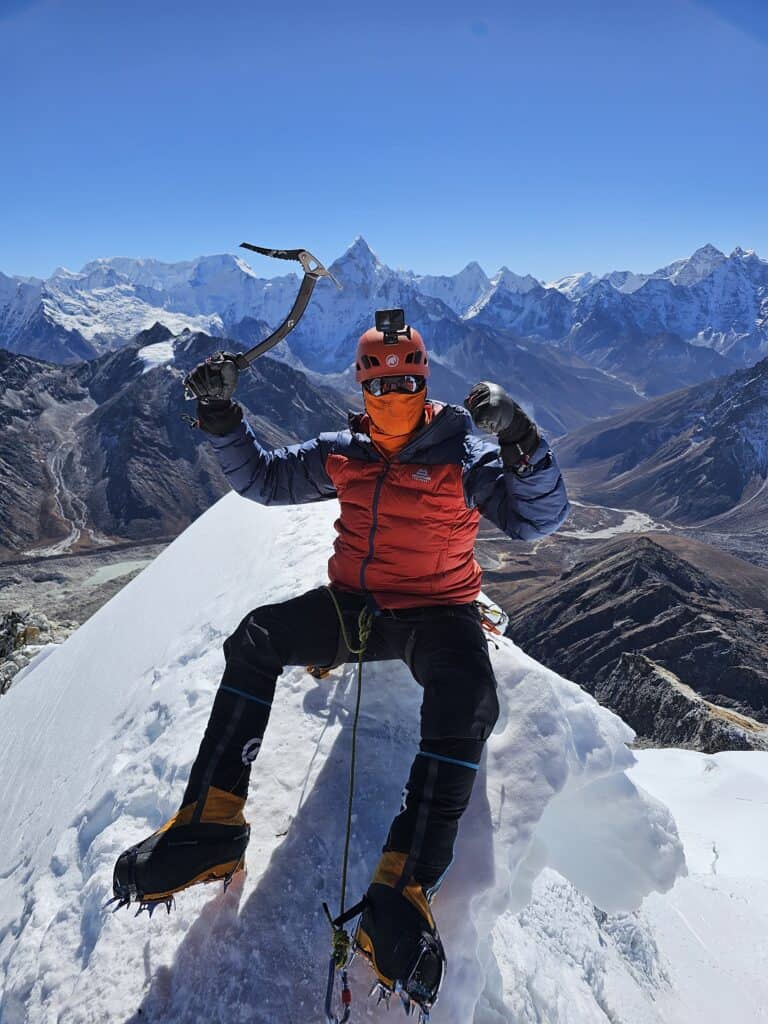Lobuche East Peak 6,119m – First 6,000ers Club
In 2023, I took on one of the biggest challenges in my mountaineering journey so far – summiting Lobuche East (6,119m) in Nepal. This climb was a huge step forward for me, not just physically but mentally, as part of my long-term goal of high-altitude mountaineering and preparing for bigger mountains in the future.
The Build-Up
Before heading to Nepal, I put in months of training back home in the UK. Long days out in Snowdonia, hiking the Wainwrights, and training my legs and lungs for the altitude ahead. But as anyone who’s climbed at high altitude knows, you can’t fully prepare for how your body will react until you’re actually there.
Lobuche was going to be my highest climb yet stepping into the 6,000m+ world for the first time. I knew this climb would give me real experience at the kind of altitudes I’d face on future big expeditions.
The 3 Passes Trek & Everest Base Camp
Before attempting Lobuche, I took on one of the most stunning and toughest treks in Nepal the 3 Passes Trek. This route took me across Kongma La (5,535m), Cho La (5,420m), and Renjo La (5,360m), offering incredible views of some of the highest mountains on Earth.
Crossing these high passes was no joke long days, thin air, cold mornings, and plenty of challenging terrain. But every single step was worth it. I was fully immersed in the heart of the Himalayas, constantly surrounded by massive peaks like Ama Dablam, Lhotse, and Everest itself.
As part of the trek, I also visited Everest Base Camp. Standing there, knowing one day I would return to attempt the summit of Everest itself, was a powerful moment for me. It reminded me of why I’ve committed myself to this journey and where I’m heading in the future.
Climbing Lobuche
After completing the 3 Passes and EBC trek, I returned to Lobuche Base Camp to prepare for my final objective the summit of Lobuche East.
Summit day started early, in freezing conditions, under the stars. We climbed steadily in the dark, making our way up a mix of rocky sections and steep snow and ice slopes. The altitude hit hard, but mentally I stayed focused on the goal.
After a long, exhausting push, I reached the summit of Lobuche East at 6,119m. Standing up there, above the clouds, with breathtaking 360° views of the Himalayas, was one of the proudest moments of my life. It felt like a reward for all the hard work, sacrifice, and determination over the years.
Lessons Learned
Lobuche taught me a lot about high altitude. I learned how my body reacts, how important proper acclimatisation is, and how critical mental strength becomes when the physical side starts to fade. The 3 Passes Trek also gave me the best possible acclimatisation, which I believe played a big part in my success on Lobuche.
This whole trip boosted my confidence for future climbs and confirmed my passion for high-altitude mountaineering.
What’s Next
Lobuche was a key part of my preparation for even bigger goals. Since then, my focus has shifted towards my ultimate dream – climbing Mount Everest. The experience I gained during the 3 Passes, EBC, and Lobuche has already proven valuable as I build towards Everest 2026 as part of my Beyond 7 Summits project.
Looking back, 2023 and my Lobuche climb will always be a special chapter in my story. It’s a reminder of how far I’ve come, and how much more there is still to do.
Fact Summary
Lobuche East is a 6,119-meter peak located in Nepal’s Khumbu region, near Everest Base Camp.
It is classified as a trekking peak but requires alpine climbing skills, including use of ropes, crampons, and ice axe.
The peak offers incredible panoramic views of Everest, Lhotse, Nuptse, Ama Dablam, and other major Himalayan giants.
The standard route includes steep snow and ice slopes, with a challenging final ridge to the true summit.
First officially climbed in 1984 via the trekking peak route, though local ascents likely occurred earlier.
Climbers must obtain a permit from the Nepal Mountaineering Association (NMA), as it is a regulated trekking peak.
Best climbed in the pre-monsoon (April-May) and post-monsoon (October-November) seasons, when conditions are most stable.
Due to the high altitude, acclimatization is critical to reduce the risk of Acute Mountain Sickness (AMS).

